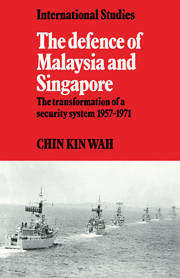Book contents
- Frontmatter
- Contents
- Preface
- Acknowledgements
- List of abbreviations
- Note on currency units
- 1 Introduction
- 2 Pre-treaty defence relations
- 3 Decolonisation and the institution of the defence agreement
- 4 The extension of AMDA
- 5 The external testing of AMDA
- 6 Towards a closing of ranks
- 7 The fractured axis
- 8 Britain weighs anchor
- 9 From AMDA to the five-power defence system
- 10 Conclusions
- Postscript on five-power arrangements
- Notes
- Bibliography
- Index
2 - Pre-treaty defence relations
Published online by Cambridge University Press: 07 October 2011
- Frontmatter
- Contents
- Preface
- Acknowledgements
- List of abbreviations
- Note on currency units
- 1 Introduction
- 2 Pre-treaty defence relations
- 3 Decolonisation and the institution of the defence agreement
- 4 The extension of AMDA
- 5 The external testing of AMDA
- 6 Towards a closing of ranks
- 7 The fractured axis
- 8 Britain weighs anchor
- 9 From AMDA to the five-power defence system
- 10 Conclusions
- Postscript on five-power arrangements
- Notes
- Bibliography
- Index
Summary
Collaboration among the partners involved in the defence of the Malaya–Singapore area did not begin with AMDA. Nor did it end with the treaty's demise. Among the external powers, pre-AMDA defence relations were regularised under a loose consultative arrangement known as ANZAM, which was later subsumed under AMDA, which in turn was replaced by the five-power defence arrangements. Although the fortunes of AMDA were influenced more by changes from within the alliance than from its international environment, the pre-treaty phase of intra-alliance relations (when Malaya itself was still largely a de jure ‘object’ of international relations) did bear the imprint of systemic influences. Australia's commitment of ground forces to Malaya was founded on wider considerations than the immediate problem of Malayan security. Events in Indochina in 1954 had an important bearing on the decision, taken within the ANZAM framework of consultation (established since 1948), to form the CSR which had to be accommodated within a formal Anglo-Malayan treaty when Malaya attained independence. The legacy of the pre-treaty relationships was reflected in the structure of AMDA.
The convergence of British, Australian, New Zealand and Malayan interests which resulted in the making of AMDA with its singular structure represented a culmination rather than a beginning. Indeed post-war Commonwealth co-operation in Malayan defence antedated AMDA by several years. The vague outline of such co-operation emerged in the late forties.
- Type
- Chapter
- Information
- The Defence of Malaysia and SingaporeThe Transformation of a Security System 1957–1971, pp. 8 - 22Publisher: Cambridge University PressPrint publication year: 1982



